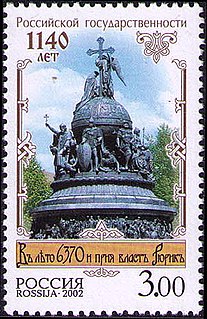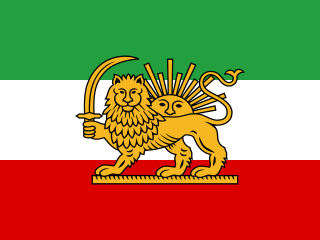
The East Slavic languages constitute one of three regional subgroups of Slavic languages, currently spoken throughout Eastern Europe, Northern Asia, and the Caucasus. It is the group with the largest numbers of speakers, far out-numbering the Western and Southern Slavic groups. The existing East Slavic languages are Belarusian, Russian and Ukrainian; Rusyn is considered to be either a separate language or a dialect of Ukrainian.

The history of Russia begins with that of the East Slavs and the Finno-Ugric peoples. The traditional beginning of Russian history is the establishment of Kievan Rus', the first united Eastern Slavic state, in 882, but in fact, only Ukraine and Belarus were true successors of statehood of Rus' entering the Grand Duchy of Lithuania later. The state adopted Christianity from the Byzantine Empire in 988, beginning the synthesis of Byzantine and Slavic cultures that defined Orthodox Slavic culture for the next millennium. Kievan Rus' ultimately disintegrated as a state due to the Mongol invasions in 1237–1240 along with the resulting deaths of about half the population of Rus'.

The Ottoman Empire, historically known in Western Europe as the Turkish Empire or simply Turkey, was a state that controlled much of Southeast Europe, Western Asia and North Africa between the 14th and early 20th centuries. It was founded at the end of the 13th century in northwestern Anatolia in the town of Söğüt by the Oghuz Turkish tribal leader Osman I. After 1354, the Ottomans crossed into Europe, and with the conquest of the Balkans, the Ottoman beylik was transformed into a transcontinental empire. The Ottomans ended the Byzantine Empire with the 1453 conquest of Constantinople by Mehmed the Conqueror.

The Soviet Union, officially the Union of Soviet Socialist Republics (USSR), was a socialist state in Eurasia that existed from 1922 to 1991. Nominally a union of multiple national Soviet republics, its government and economy were highly centralized. The country was a one-party state, governed by the Communist Party with Moscow as its capital in its largest republic, the Russian Soviet Federative Socialist Republic. Other major urban centres were Leningrad, Kiev, Minsk, Alma-Ata, and Novosibirsk. It spanned over 10,000 kilometres east to west across 11 time zones, and over 7,200 kilometres north to south. It had five climate zones: tundra, taiga, steppes, desert and mountains.

World War II, also known as the Second World War, was a global war that lasted from 1939 to 1945. The vast majority of the world's countries—including all the great powers—eventually formed two opposing military alliances: the Allies and the Axis. A state of total war emerged, directly involving more than 100 million people from over 30 countries. The major participants threw their entire economic, industrial, and scientific capabilities behind the war effort, blurring the distinction between civilian and military resources. World War II was the deadliest conflict in human history, marked by 50 to 85 million fatalities, most of whom were civilians in the Soviet Union and China. It included massacres, the genocide of the Holocaust, strategic bombing, premeditated death from starvation and disease, and the only use of nuclear weapons in war.

The Kyzylkum Desert is the 15th largest desert in the world. Its name means Red Sand in Turkic languages. It is located in Central Asia in the doab between the rivers Amu Darya and Syr Darya, a region historically known as Transoxania or Sogdiana. Today it is divided between Kazakhstan, Uzbekistan and Turkmenistan. It covers about 298,000 km2 (115,000 sq mi).

Ivan IV Vasilyevich, commonly known as Ivan the Terrible, was the Grand Prince of Moscow from 1533 to 1547 and the first Tsar of Russia from 1547 to 1584.

In Eastern Orthodox church history especially within Russian Orthodox Church, the Old Believers or Old Ritualists are Eastern Orthodox Christians who maintain the liturgical and ritual practices of the Eastern Orthodox Church as they existed prior to the reforms of Patriarch Nikon of Moscow between 1652 and 1666. Resisting the accommodation of Russian piety to the contemporary forms of Greek Orthodox worship, these Christians were anathematized, together with their ritual, in a Synod of 1666–1667, producing a division in Eastern Europe between the Old Believers and those who followed the state church in its condemnation of the Old Rite.

The Treaty of Berlin was signed on 13 July 1878. In the aftermath of the Russian victory against the Ottoman Empire, the major powers restructured the map of the Balkan region. They reversed some of the extreme gains claimed by Russia in the preliminary Treaty of San Stefano, but the Ottomans lost their major holdings in Europe. It was one of three major peace agreements in the period after the 1815 Congress of Vienna. It was the final act of the Congress of Berlin and included Great Britain and Ireland, Austria-Hungary, France, Germany, Italy, Russia and the Ottoman Empire. Germany's Otto von Bismarck was the chairman and dominant personality.

Pyotr Leonidovich Kapitsa or Peter Kapitza (Russian: Пётр Леони́дович Капи́ца, Romanian: Petre Capiţa was a leading Soviet physicist and Nobel laureate, best known for his work in low-temperature physics.

The Qajar dynasty was an Iranian royal dynasty of Turkic origin, specifically from the Qajar tribe, which ruled Persia (Iran) from 1789 to 1925. The state ruled by the dynasty was officially known as the Sublime State of Persia. The Qajar family took full control of Iran in 1794, deposing Lotf 'Ali Khan, the last Shah of the Zand dynasty, and re-asserted Iranian sovereignty over large parts of the Caucasus. In 1796, Mohammad Khan Qajar seized Mashhad with ease, putting an end to the Afsharid dynasty, and Mohammad Khan was formally crowned as Shah after his punitive campaign against Iran's Georgian subjects. In the Caucasus, the Qajar dynasty permanently lost many of Iran's integral areas to the Russians over the course of the 19th century, comprising modern-day Georgia, Dagestan, Azerbaijan and Armenia.

The 1793 Second Partition of Poland was the second of three partitions that ended the existence of the Polish–Lithuanian Commonwealth by 1795. The second partition occurred in the aftermath of the Polish–Russian War of 1792 and the Targowica Confederation of 1792, and was approved by its territorial beneficiaries, the Russian Empire and the Kingdom of Prussia. The division was ratified by the coerced Polish parliament (Sejm) in 1793 in a short-lived attempt to prevent the inevitable complete annexation of Poland, the Third Partition.
Bourgeois pseudoscience was a term of condemnation in the Soviet Union for certain scientific disciplines that were deemed unacceptable from an ideological point of view.

The Treaty of Turkmenchay was an agreement between Persia (Iran) and the Russian Empire, which concluded the Russo-Persian War (1826–28). It was signed on 10 February 1828 in Torkamanchay, Iran. By the treaty, Persia ceded to Russia control of several areas in the South Caucasus: the Erivan Khanate, the Nakhchivan Khanate, and the remainder of the Talysh Khanate. The boundary between Russian and Persia was set at the Aras River. These territories comprise modern-day Armenia, the southern parts of the modern-day Republic of Azerbaijan, Nakhchivan, as well as Iğdır Province.

The Moscow Art Theatre is a theatre company in Moscow. It was founded in 1898 by the seminal Russian theatre practitioner Konstantin Stanislavski, together with the playwright and director Vladimir Nemirovich-Danchenko. It was conceived as a venue for naturalistic theatre, in contrast to the melodramas that were Russia's dominant form of theatre at the time. The theatre, the first to regularly put on shows implementing Stanislavski's system, proved hugely influential in the acting world and in the development of modern American theatre and drama.
Jewish Bolshevism, also Judeo–Bolshevism, is an anti-communist and antisemitic canard, which alleges that the Jews were the originators of the Russian Revolution in 1917 and that they held the primary power among the Bolsheviks. Similarly, the conspiracy theory of Jewish Communism implies that Jews have dominated the Communist movements in the world, and is related to The Zionist Occupation Government conspiracy theory (ZOG), which asserts that Jews control world politics.
The Treaty of ConstantinopleRusso-Ottoman Treaty or Treaty of the Partition of Persia was a treaty concluded on 24 June 1724 between the Ottoman Empire and the Russian Empire, dividing large portions of the territory of mutually neighbouring Safavid Iran between them.
Tsarist autocracy is a form of autocracy specific to the Grand Duchy of Moscow, which later became Tsardom of Russia and the Russian Empire. In it, all power and wealth is controlled by the Tsar. They had more power than constitutional monarchs, who are usually vested by law and counterbalanced by a legislative authority; they even had more authority on religious issues compared to Western monarchs. In Russia, it originated during the time of Ivan III (1440−1505), and was abolished after the Russian Revolution of 1917.
The Soviet invasion of Xinjiang was a military campaign of the Soviet Union in the Chinese northwestern region of Xinjiang in 1934. White Russian forces assisted the Soviet Red Army.















